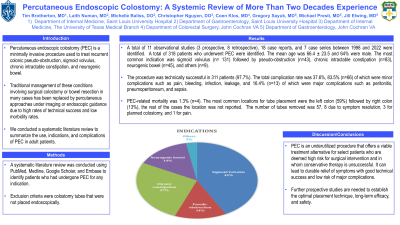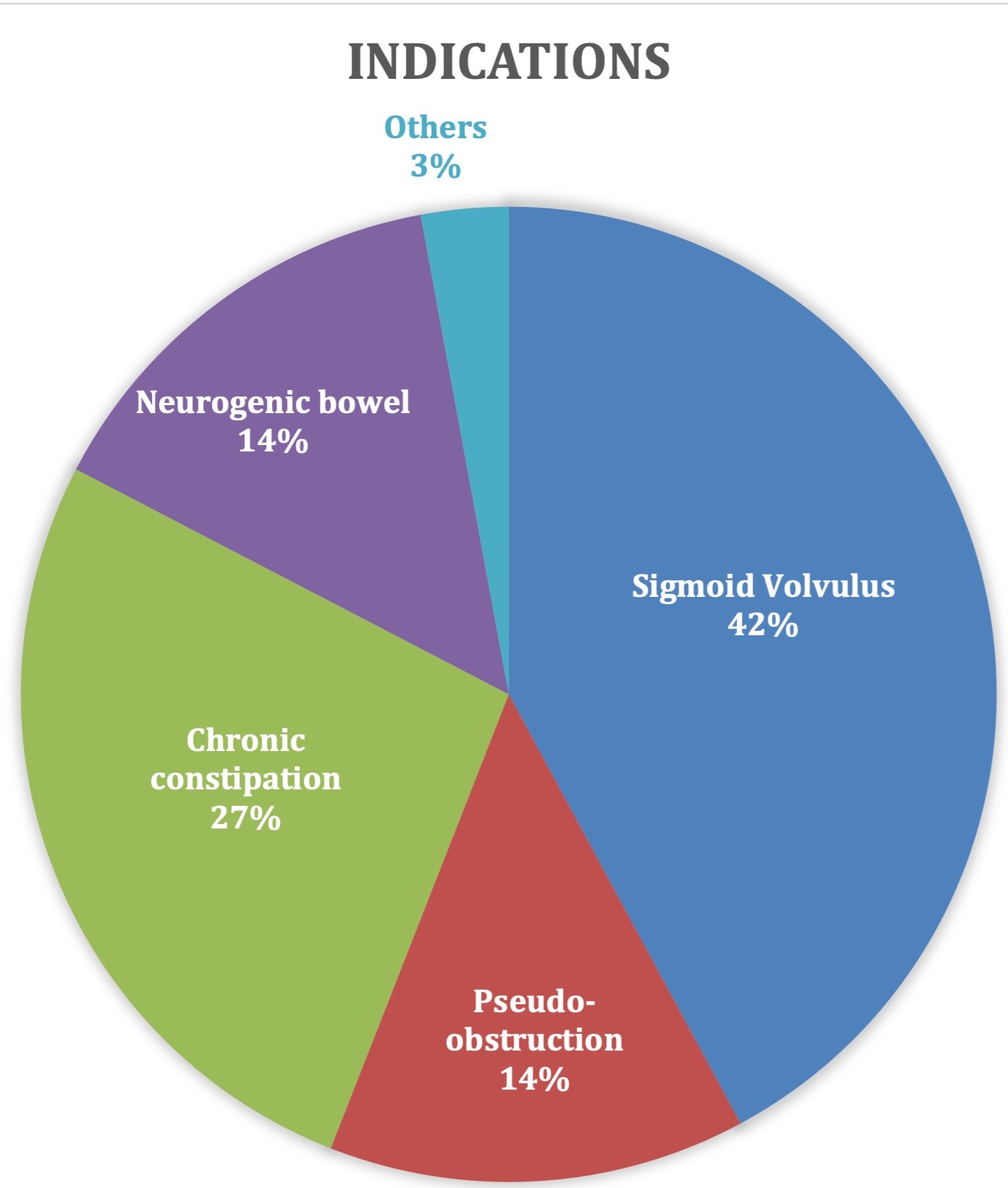Back


Poster Session E - Tuesday Afternoon
Category: Colon
E0086 - Percutaneous Endoscopic Colostomy: A Systematic Review of More Than Two Decades Experience
Tuesday, October 25, 2022
3:00 PM – 5:00 PM ET
Location: Crown Ballroom

Has Audio
- TB
Tim Brotherton, MD
Saint Louis University
St. Louis, Missouri
Presenting Author(s)
Tim Brotherton, MD1, Laith Numan, MD1, Michelle Baliss, DO1, Christopher Nguyen, DO2, Coen L. Klos, MD3, Gregory Sayuk, MD4, Michael Presti, MD5, Jill E. Elwing, MD4
1Saint Louis University, St. Louis, MO; 2University of Texas Medical Branch, Galveston, TX; 3Washington University in St. Louis, St. Louis, MO; 4St. Louis VA, Washington University, St. Louis, MO; 5St. Louis VA, Saint Louis University, St. Louis, MO
Introduction: Percutaneous endoscopic colostomy (PEC) is a minimally invasive procedure used to treat recurrent colonic pseudo-obstruction, sigmoid volvulus, chronic intractable constipation, and neurogenic bowel. Traditional management of these conditions involving surgical colostomy or bowel resection in many cases has been replaced by percutaneous approaches under imaging or endoscopic guidance due to high rates of technical success and low morbidity rates. We conducted a systematic literature review to summarize the use, indications, and complications of PEC in adult patients.
Methods: A systematic literature review was conducted using PubMed, Medline, Google Scholar, and Embase to identify patients who had undergone PEC for any indication. The search terms used were “percutaneous endoscopic colostomy”, “percutaneous endoscopic cecostomy”, “percutaneous cecostomy”, and “percutaneous colostomy”. Exclusion criteria were colostomy tubes that were not placed endoscopically.
Results: A total of 11 observational studies (3 prospective, 8 retrospective), 18 case reports, and 7 case series between 1998 and 2022 were identified. A total of 318 patients who underwent PEC were identified. The mean age was 66.4 ± 23.5 and 64% were male. The most common indication was sigmoid volvulus (n= 131) followed by pseudo-obstruction (n=43), chronic intractable constipation (n=83), neurogenic bowel (n=45), and others (n=9). The procedure was technically successful in 311 patients (97.7%). The total complication rate was 37.6%, 83.5% (n=66) of which were minor complications such as pain, bleeding, infection, leakage, and 16.4% (n=13) of which were major complications such as peritonitis, pneumoperitoneum, and sepsis. PEC-related mortality was 1.3% (n=4). The most common locations for tube placement were the left colon (59%) followed by right colon (13%), the rest of the cases the location was not reported. The number of tubes removed was 57, 8 due to symptom resolution, 3 for planned colostomy, and 1 for pain.
Discussion: PEC is an underutilized procedure that offers a viable treatment alternative for select patients who are deemed high risk for surgical intervention and in whom conservative therapy is unsuccessful. It can lead to durable relief of symptoms with good technical success and low risk of major complications. Further prospective studies are needed to establish the optimal placement technique, long-term efficacy, and safety.

Disclosures:
Tim Brotherton, MD1, Laith Numan, MD1, Michelle Baliss, DO1, Christopher Nguyen, DO2, Coen L. Klos, MD3, Gregory Sayuk, MD4, Michael Presti, MD5, Jill E. Elwing, MD4. E0086 - Percutaneous Endoscopic Colostomy: A Systematic Review of More Than Two Decades Experience, ACG 2022 Annual Scientific Meeting Abstracts. Charlotte, NC: American College of Gastroenterology.
1Saint Louis University, St. Louis, MO; 2University of Texas Medical Branch, Galveston, TX; 3Washington University in St. Louis, St. Louis, MO; 4St. Louis VA, Washington University, St. Louis, MO; 5St. Louis VA, Saint Louis University, St. Louis, MO
Introduction: Percutaneous endoscopic colostomy (PEC) is a minimally invasive procedure used to treat recurrent colonic pseudo-obstruction, sigmoid volvulus, chronic intractable constipation, and neurogenic bowel. Traditional management of these conditions involving surgical colostomy or bowel resection in many cases has been replaced by percutaneous approaches under imaging or endoscopic guidance due to high rates of technical success and low morbidity rates. We conducted a systematic literature review to summarize the use, indications, and complications of PEC in adult patients.
Methods: A systematic literature review was conducted using PubMed, Medline, Google Scholar, and Embase to identify patients who had undergone PEC for any indication. The search terms used were “percutaneous endoscopic colostomy”, “percutaneous endoscopic cecostomy”, “percutaneous cecostomy”, and “percutaneous colostomy”. Exclusion criteria were colostomy tubes that were not placed endoscopically.
Results: A total of 11 observational studies (3 prospective, 8 retrospective), 18 case reports, and 7 case series between 1998 and 2022 were identified. A total of 318 patients who underwent PEC were identified. The mean age was 66.4 ± 23.5 and 64% were male. The most common indication was sigmoid volvulus (n= 131) followed by pseudo-obstruction (n=43), chronic intractable constipation (n=83), neurogenic bowel (n=45), and others (n=9). The procedure was technically successful in 311 patients (97.7%). The total complication rate was 37.6%, 83.5% (n=66) of which were minor complications such as pain, bleeding, infection, leakage, and 16.4% (n=13) of which were major complications such as peritonitis, pneumoperitoneum, and sepsis. PEC-related mortality was 1.3% (n=4). The most common locations for tube placement were the left colon (59%) followed by right colon (13%), the rest of the cases the location was not reported. The number of tubes removed was 57, 8 due to symptom resolution, 3 for planned colostomy, and 1 for pain.
Discussion: PEC is an underutilized procedure that offers a viable treatment alternative for select patients who are deemed high risk for surgical intervention and in whom conservative therapy is unsuccessful. It can lead to durable relief of symptoms with good technical success and low risk of major complications. Further prospective studies are needed to establish the optimal placement technique, long-term efficacy, and safety.

Figure: Percutaneous Endoscopic Colostomy tube indications
Disclosures:
Tim Brotherton indicated no relevant financial relationships.
Laith Numan indicated no relevant financial relationships.
Michelle Baliss indicated no relevant financial relationships.
Christopher Nguyen indicated no relevant financial relationships.
Coen Klos indicated no relevant financial relationships.
Gregory Sayuk indicated no relevant financial relationships.
Michael Presti indicated no relevant financial relationships.
Jill Elwing indicated no relevant financial relationships.
Tim Brotherton, MD1, Laith Numan, MD1, Michelle Baliss, DO1, Christopher Nguyen, DO2, Coen L. Klos, MD3, Gregory Sayuk, MD4, Michael Presti, MD5, Jill E. Elwing, MD4. E0086 - Percutaneous Endoscopic Colostomy: A Systematic Review of More Than Two Decades Experience, ACG 2022 Annual Scientific Meeting Abstracts. Charlotte, NC: American College of Gastroenterology.
